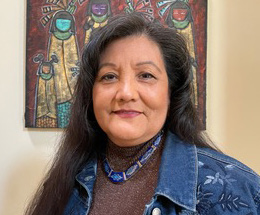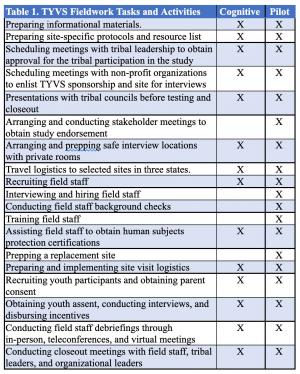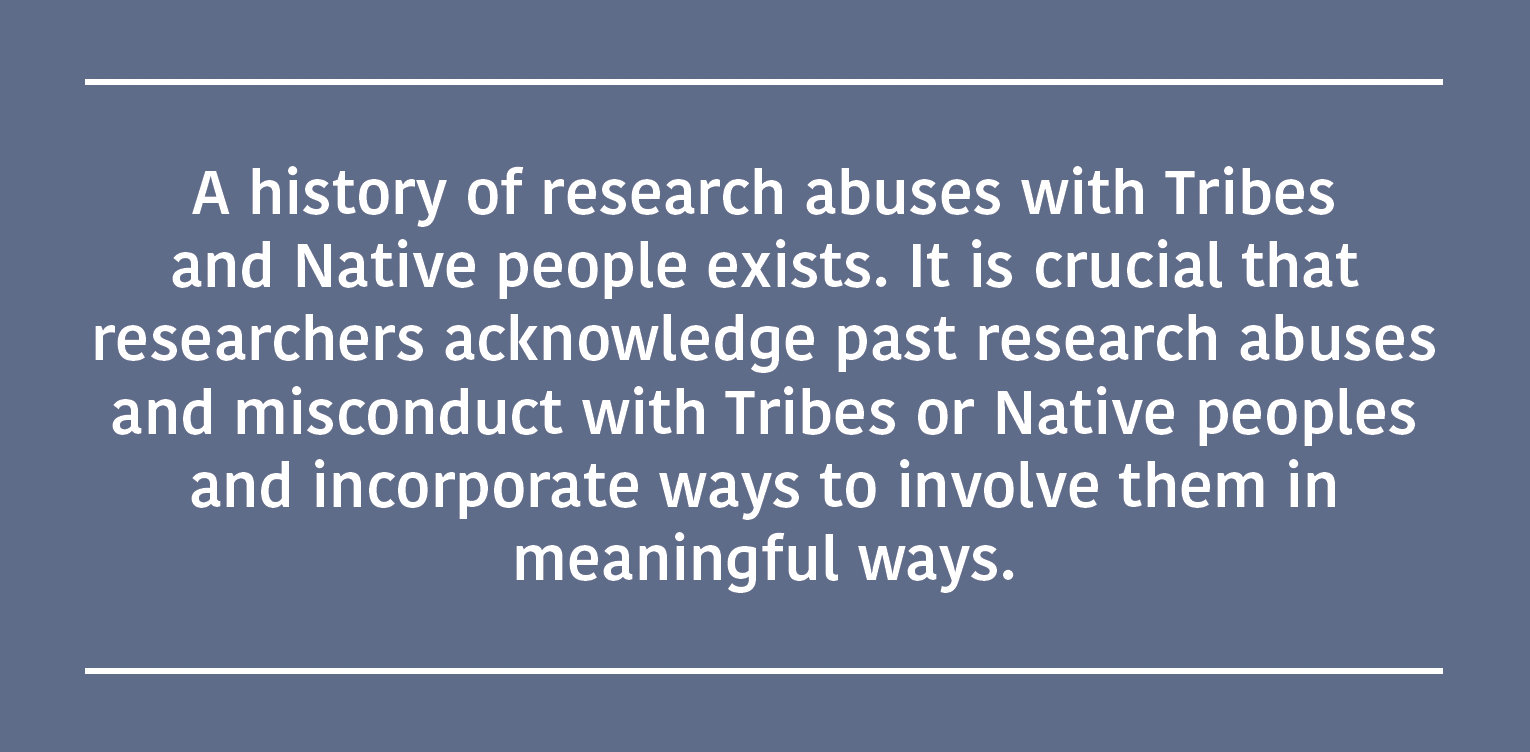VAWA National Tribal Baseline Study Update

Ada Pecos Melton. (Photo courtesy of American Indian Development Associates, LLC.)
Research is a multifaceted endeavor with many aspects in motion at the same time or in sequence. It involves extensive preparation before a study team hits the ground to conduct onsite data collection.
When Does Fieldwork Preparation Begin?
Preparation begins with the research design, which describes all the aspects or components the study involves. It includes a literature review describing what we know about the study area, the knowledge gaps, and what the study will examine or hope to discover. The research design states the study purpose, objectives, and expected outcomes. It lays the foundation for data collection, including developing the questionnaire or survey instruments and methods for review and approval. Finally, the design describes strategies for selecting the target population, often referred to as human subjects, respondents, or participants. Some Tribes use “relatives” to refer to individuals participating in a study.
A history of research abuses with Tribes and Native people exists.1
Acknowledging ongoing concerns for culturally relevant and respectful research, the 2005 Violence Against Women Act (VAWA) Section 904 includes a statutorily mandated Federal Advisory Task Force. This legislation authorizes the National Institute of Justice (NIJ) to conduct the National Baseline Study (NBS).2 The Task Force’s role is to assist in developing pertinent research questions, provide feedback on NIJ’s violence against Indian women-related research, and assist with recommendations resulting from study findings.3 This legislation elevated standards requiring concrete strategies for Tribal participatory methods and approaches in Tribal research studies receiving federal funding.
It is crucial that researchers acknowledge past research abuses and misconduct with Tribes or Native peoples and incorporate ways to involve them in meaningful ways. AIDA includes research designs that incorporate participatory approaches to ensure Native input and perspectives. AIDA implemented the fieldwork for the Tribal youth victimization pilot study (TYVS)4 and is responsible for the NBS fieldwork.
TYVS Participatory Methods
AIDA set up a Tribal advisory group (TAG) composed of Tribal experts to review the study design and instruments and provide guidance. The transition from identifying topical areas to developing what questions to use for a national survey of Native youth incorporated the TAG’s input. The objective was to obtain clarity concerning definitions, priority areas, and the scope of data collection. The TAG’s review enabled an effective balance of pertinent issues for inclusion in the questionnaire. Their contributions helped the study team gain a comprehensive perspective on violence and victimization affecting Native youth. The TAG’s comments included recommendations for culturally relevant and respectful approaches for Tribal engagement. Their suggestions included participatory methods for obtaining Tribal approvals, community outreach and education, hiring Indigenous field staff, and recruiting Native youth.
Research designs describe methods to provide information about the study as it starts, during data collection, and as data findings and results become available. The data collection plan is a critical research design component. The main objective of fieldwork is data collection using the created tools or instruments and methods. It also documents the data collection experience, which yields a compilation of lessons learned. During data collection, the NBS includes in-person computer-assisted interviews using the study questionnaire. AIDA used this method for the TYVS, which included transmitting the encrypted data to a data center.
Fieldwork or Implementing the Data Collection Plan

The TYVS consisted of three phases: 1) design of a Tribal youth survey, 2) cognitive testing of the survey, and 3) pilot testing the final draft Tribal youth survey. The fieldwork components included: 1) recruiting Tribal or organization participants, 2) recruiting, hiring, and training local field staff, 3) recruiting youth participants, 4) conducting computer-assisted interviews and interviewer debriefings, and 5) conducting closeout meetings with field staff, Tribal councils or representatives, and organizations where onsite data collection occurred.
The AIDA study team performed the fieldwork for Tribal or organization recruitment–recruiting, hiring, training field staff–and closeout meetings. The TYVS field staff recruited youth participants, obtained parental consent and youth assent, and conducted in-person computer-assisted interviews.
The data collection at three sites for each testing phase occurred at multiple locations simultaneously or overlapped. Altogether, the fieldwork for each stage involved the tasks and activities listed in Table 1.
NBS Data Collection
The NBS data collection plan involves extensive onsite data collection that includes similar fieldwork tasks and activities. Careful preparation and documentation are necessary for each step in Table 1. AIDA assisted the NIJ and the Research Triangle Institute (RTI) International with the NBS cognitive and pilot tests.5 The study team applies the lessons learned from the TYVS and earlier NBS study components to current NBS efforts.

Research Realities
Life Happens with Tribal Research
Targeted research in Tribal communities is often a test of willingness to compromise and finding creative solutions to challenging problems. It includes the ability to stay true to the main fieldwork objective—to collect data onsite. Fieldwork is the essential component connecting instrumentation development with data analysis. Fieldwork gives life to research methods, like the TYVS and NBS questionnaires and the Tribal engagement methods for recruiting Tribes, study participants, and community involvement. It provides the data for analysis, thereby supporting the end goal for new knowledge and a better understanding of Native people’s experiences.
Both the TYVS and NBS have and are experiencing many interruptions, delays, challenges, and setbacks. Federally funded national studies are entangled by government-controlled decisions and changes. During TYVS, a federal government shutdown changed NIJ’s involvement level and the government’s approval requirements. These decisions delayed and hindered progress. Tribal government setbacks during the TYVS included natural disasters with flooding and public health emergencies, causing two Tribes to withdraw, one during cognitive testing and the other during pilot testing. The study period prohibited site replacement for cognitive testing. The team recruited a Tribal replacement for the pilot testing. While study extensions were considered, it was not possible due to legislation limiting one of the federal funding sources to allow no-cost funding extensions. Despite a seemingly endless stream of challenges and impediments, the TYVS fieldwork for cognitive and pilot testing at three sites was completed within eight months.
Another public health emergency, the COVID-19 pandemic, is affecting the NBS fieldwork for Tribal recruitment. The AIDA study team is conducting multi-site Tribal recruitment virtually. The full impact of the pandemic on fieldwork is unknown, but the team anticipates start-up delays.
Perseverance Happens with Tribal Research
The pandemic presents challenges requiring the NIJ and the study team to rethink the research design, fieldwork study methods, and approaches for Tribal recruitment. The study team employs several ways to communicate with Tribes through phone calls, emails, and different virtual meeting platforms. The team works with Tribal staff to prepare Tribal approval documents and information materials using virtual methods. Many Tribes now have secure COVID-related virtual systems supporting government operations, which the study team follows.
The onsite activities involve recruiting households and study participants and conducting in-person interviews with those who volunteer. It also includes extensive onsite interaction among the study team and field staff and possibly each tribe’s designated Tribal point of contact. The study has several COVID-related protocols addressing personal health protection and safety during household recruitment, in-person interviews, facility preparation, equipment sanitizing, and meetings among field staff and with Tribal representatives or the community. These protocols follow national standards and will incorporate Tribe-specific requirements.
Summary
Although the pandemic raises serious concerns for the safety of participants and the field staff, it is vital to stay focused on the study’s purposes and end results. The NBS is still an urgent and critical study. The pandemic adds to the urgency of the study. American Indian and Alaska Native Tribes are resilient. We stand on the shoulders of Native leaders and activists such as the NIWRC constituents, who are called upon to help the study continue by encouraging Tribal leaders to approve the study when it comes to your Tribe.
-
For more information, see https://n8ve.net/OrKAR
-
For more NBS information, see https://bit.ly/3qpVv2w
-
Crossland, C., J. Palmer, and A. Brooks (2013). NIJ’s program of research on violence against American Indian and Alaska Native women. Violence Against Women 19 (6) 771-790.
-
For information on victimization studies, see https://n8ve.net/bkNb1
-
For more information, see https://n8ve.net/KJVXj





